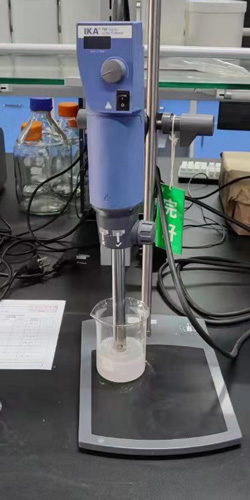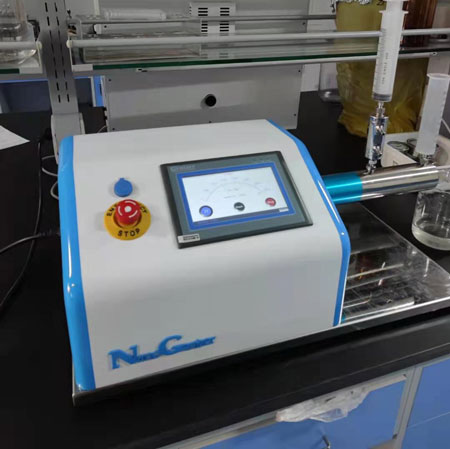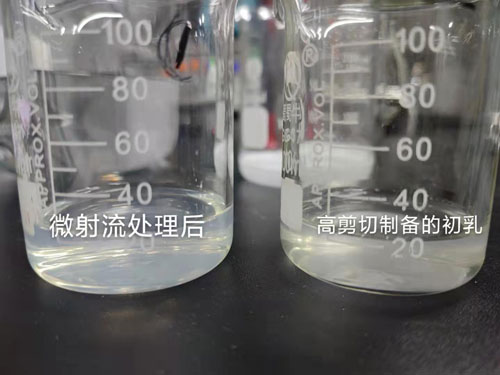苏州微流纳米生物技术有限公司
MF59 adjuvant has been successfully used in a variety of human virus vaccines (including as an adjuvant for influenza vaccines). The microfluidization preparation of this nanoemulsion type adjuvant has attracted the attention of more and more workers in the cutting-edge field. This article will briefly introduce the concept of vaccine adjuvants, common adjuvant types, and the preparation process and results of MF59 adjuvant.
Adjuvants are widely used in a variety of vaccines and can enhance the body's immune response to antigens and significantly improve the effect of vaccines. As an immune enhancer, adjuvants can not only reduce the amount of antigen used in vaccines, but also quickly activate the immune system. Preservation is of great significance to people with low immunity such as the elderly and children. Although aluminum adjuvant has been used in clinical practice as a classic representative adjuvant for nearly a century, the development and research of new adjuvants have just emerged and has gradually become an important area in today's vaccine research. The new adjuvant has a stronger immune activation effect than the classic aluminum adjuvant. However, it is unclear whether this amplification effect of immune activity will disrupt the body's normal immune system function.
There are very few human adjuvants on the market. In addition to traditional aluminum adjuvants, Europe has approved oil-in-water emulsions MF59 and AS03 (adjuvant system03) for influenza vaccines; in the United States and Europe, AS04 (adjuvant system 04) has been used for HBV and HPV. With the continuous deepening of people's research on the immune system in recent years, Toll-like receptors (TLRs) have attracted much attention as a potential new emerging point of adjuvant. Some TLR-dependent adjuvants continue to emerge: such as the TLR3 agonist polyinosinic (I:C); the TLR4 agonist Monophosphory Lipid A (MPL) in AS04; the TLR5 agonist flagellin; the TLR7 and TLR8 agonists are ssRNAs rich in guanine and uracil; the TLR9 agonist is dsDNA cytosine phosphate guanine oligodeoxynucleotide (CpG-ODN) containing a CpG motif.
Brief description of different types of adjuvants:
1. Aluminum adjuvant
Among insoluble salt colloidal adjuvants, aluminum adjuvant is one of the more commonly used adjuvants. In recombinant protein vaccines for hepatitis B virus (HBV) and human papilloma virus (HPV), alum alone is used as an adjuvant to induce a protective immune response. HIV vaccines require not only an effective and lasting immune response, but also T cells. Specific response, while aluminum adjuvant is less effective in the application of HIV vaccines. Aluminum salt adjuvants are approved in many human vaccine applications, including diphtheria pertussis tetanus (DPT) vaccine, Haemophilus influenza vaccine, poliovirus vaccine, hepatitis A vaccine, Streptococcus pneumoniae vaccine, Diplococcus meningitidis vaccine and human papilloma virus vaccine. The main mechanism of action of aluminum adjuvant is to form a complex with antigen. This complex is an antigen reservoir. Its stability determines the release rate of antigen. It can slowly release antigen and prolong the action time of antigen. This particulate structure can enhance the ability of APCs such as dendritic cells, macrophages and B cells to swallow antigens, and can increase the expression of MHC-II molecules and antigen presentation. Recent studies have shown that aluminum adjuvant can induce the secretion of chemokines in monocytes and macrophages, and can promote the aggregation and migration of inflammatory monocytes into lymph nodes at the injection site of aluminum adjuvant, and further differentiation into inflammatory dendritic cells. Aluminum adjuvants usually stimulate the production of Th2-type immune responses rather than a significant T-cell response. The main advantages of aluminum adjuvant are its high safety, better effect of enhancing the response of stimulating antibodies (faster and higher antibody titers, longer immune reactions), relatively stable antigen, and suitable for large-scale production applications. The formula is simple. Aluminum adjuvants can also cause local granulomas at the injection site, a feature that needs to be noted if immunization is boosted frequently.
2.
The two basic types of nanoemulsion adjuvant nanoemulsions are O/W (oil-in-water) and W/O (water-in-oil). In recent years, people have gradually developed several multiple emulsions, which are mainly a mixture of two basic types of emulsifiers, such as W/O/W or O/W/O. The new water-in-oil emulsion Montanide ISA is a series of oil adjuvants that can be used to formulate different types of emulsifiers, such as O/W, W/O or W/O/W. This adjuvant is mainly based on mineral oil, non-mineral oil and a mixture of the two. It also has a specific surface chemical based on mannitol. Among them, the surface-active adjuvant of Montanide ISA50 is diacetal mannitol oleate. This adjuvant has a similar effect on antibodies to that of incomplete Freund's adjuvant, but it rarely causes inflammatory reactions. The oily adjuvant Montanide is widely used in clinical trials of prostate cancer, ovarian cancer, and non-small cell lung cancer vaccines. The Cuban lung cancer vaccine CIMAvax EGF is emulsified using Montanide ISA51 and has undergone clinical Phase III trials in Latin America. MF59 is an O/W emulsifier containing 1% squalene, 0.5% polysorbate trioleate, and 0.5% Tween80 that stimulates humoral immune responses through the Th2 reaction pathway. It is currently used in an influenza vaccine developed by Novartis named Forida, which is the first vaccine approved in Europe to add MF59. Surender Khurana et al. immunized experimental animals with or without MF59 adjuvant in a certain avian influenza vaccine. From the experimental results, they found that the combination of adjuvant and vaccine can produce relevant antibodies in the body, which can recognize a wider range of different types of influenza antigens, such as certain known antibodies that can inactivate avian influenza viruses. This experiment confirmed that MF59 can increase the level of antibodies against avian influenza virus, and also increase multiple antibody types. It is speculated that these diverse antibodies may have a broader protective effect on different types of influenza viruses.
3. Liposomes and viroid
liposomes are the third largest type of traditional adjuvants. They are lipid capsules formed by single or multi-layered membrane-like structures that can encapsulate antigens and serve as antigen delivery carriers. Its effect is significantly better than that of aluminum adjuvant, has low toxic and side effects, and has good safety. It has also been confirmed in some human trials. Although liposomes have not been approved for use in vaccines, viroids (composed of the envelope protein of influenza virus) with similar compositions to liposomes have been approved for use. It also adds a functional viral envelope glycoprotein component that assists cells in uptake and delivery of antigens to target cells to promote membrane fusion. Vaccines approved for viroids include Epaxal™ (inactivated hepatitis A vaccine) and Inflexal™ V (influenza virus vaccine). Both vaccines have high immunogenicity and excellent tolerability in adults and children. For seasonal influenza vaccines, the immunogenicity of the adjuvanted vaccine did not increase significantly compared to the unadjuvanted vaccine. In one study, Inflexal™ was found to have similar immunogenicity compared to influenza vaccines supplemented with MF59 in the early stages. In another study, Fluarix™, a deactivated and purified isolated influenza vaccine without adjuvant, was found to have similar immunogenicity to the subunit vaccine Fluad™ supplemented with MF59 adjuvant or Inflexal™ V, a subunit vaccine for viroids, for subjects aged 60 and older.
4. Toll-like receptor agonists
Toll-like receptors (TLRs) recognize pathogen-associated molecular patterns in the immune system and are pathogen-recognition receptors. The discovery of TLRs and the understanding of their relationship with the innate and acquired immune systems have laid the foundation for the development of new immune adjuvants and immune enhancers. Immune enhancers mainly function as adjuvants by directly stimulating intrinsic immune cells such as monocytes, macrophages, and dendritic cells. Lipid monophosphate A(MPL), a TLR4 agonist, is one of the most popular vaccine immunostimulants. MPL is a lipopolysaccharide from Salmonella Minnesota Re595. It detoxifies by removing the phosphate and fatty acid groups in lipid A, but still has the ability to bind to TLR4. It acts on innate immune cells in the same mechanism as lipopolysaccharide. It also stimulates the expression of costimulatory molecules and the release of cytokines, thus improving cellular and humoral immunity. Other TLR receptor agonists include immunostimulatory sequences (ISS) and microbial DNA. After recognition of ISS by TLRs, the acquired immune response that follows the intrinsic immune response is significantly enhanced. Some ISSs have unique biological activities, and clinical trials have shown that the application of ISS can significantly enhance the level of humoral and cellular immune responses to vaccine antigens. This effect is reflected in vaccine candidates for different infectious diseases, such as hepatitis B, malaria, human papilloma virus and AIDS vaccines. CpG ODN is an agonist of TLR9 and can induce the secretion of pro-inflammatory factors such as TNF-α, IL-1, IL-6, IFN-α and IFNγ. It is also currently used as an immunostimulatory sequence in the treatment of tumors. Preclinical studies have found that CpGs have the ability to induce Th1 immune responses and cytotoxic T lymphocyte responses. So far, studies have found that the ISS complex is well tolerated, and more in-depth related research is underway. Imidazoquinolinamine is also a candidate adjuvant that binds to TLR7 and TLR8. This organic complex has strong antiviral activity and can mimic natural TLR receptor ligands. Studies have shown that in mouse models of HIV infection, it can increase T cell immune responses and enhance antiviral immune responses. Further research is needed for human applications, and may first be tried in cancer vaccines.
5. Saponins
are an adjuvant derived from plants. Saponin Quil A and its monomer components are extracts from the soap bark of the genus Quilaya in South America. It was earlier used in veterinary vaccines and has not been used in humans. QS21, a purified product extracted from Quil A, has been confirmed in animal experiments to enhance the antigen presenting ability of APC and induce CTL responses and Th1 and Th2 type immune responses. QS21 is well tolerated and is considered suitable for use in human vaccine candidates. Experiments have confirmed that MPL and QS21 have a good synergistic effect.
6. Immunostimulatory complexes Immunostimulatory
complexes (ISCOMs) are adjuvants that serve as antigen delivery systems. They are cage-like structures composed of lipids, cholesterol, antigen and glycoside Quil-A. They capture protein antigens through surface hydrophobic interactions and are taken up by APC through endocytosis. In animal experiments, ISCOM has successfully induced high-titer antibody responses and helper T cell and CTL responses. ISCOMATRIX has a similar structure to ISCOM, but ISCOMATRIX does not penetrate into the antigen, but connects the antigen to ISCOMATRIX to form the vaccine. Since it does not restrict the application of hydrophobic membrane proteins, it has a wider application range and the production process is simple. The immunomodulatory effect of saponin combines with the MHC-I and MHC-II molecular pathways of antigen presentation to produce a broader immune response. The prospects of ISCOMATRIX adjuvant lie in its suitable large production scale, long-term stability and rapid induction of humoral immunity. Many experiments have shown that this adjuvant has a high degree of safety and significantly improves immunogenicity in vaccine applications. Currently, ISCOMATRIX adjuvant is being tried to be used in hepatitis C, influenza and tumor vaccines.
Brief introduction to the preparation process and results of MF59 adjuvant microfluidizer:
1. Sample two-phase configuration
2. High-shear preparation of colostrum
3. Microjet high-pressure nanoscale particle
size control, comparison with standard particle size, passing through 0.22um filter membrane

map MF59 nanoemulsion adjuvant colostrum preparation

Figure High-pressure microfluidizer for preparing MF59 nanoemulsion adjuvant

Figure Experimental summary before and after preparation of MF59 adjuvant microfluidizer (dilution versus appearance)
:
After field testing, good preparation results were obtained in the first attempt. The sample showed three peaks and a large particle size after preparation of the crude emulsion. After three times of micro-fluidization treatment, the particle size and distribution state similar to that of the standard control were obtained. Moreover, the product was efficiently and quickly processed through a 0.22um filter membrane. The product was tested and processed for the previous time. The particle size, homogeneity and large particle state all meet the requirements.
微流纳米Vic